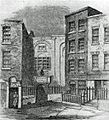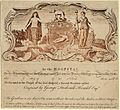Messiah (Handel) facts for kids

Messiah is a famous musical piece called an oratorio. It was written by a German composer named Georg Frideric Handel. It's his most well-known work. In England, it's one of the most performed pieces for choirs. The word Messiah means "the anointed one." It's a name given to Jesus Christ in Christian teachings.
Contents
How Messiah Was Created
Handel's Musical Journey
Georg Frideric Handel was born in Germany. When he was young, he visited England. He liked it so much that he decided to live there for the rest of his life. He even became an English citizen. People in England really enjoyed his music, which made him want to stay.
For about 20 years, Handel mostly wrote operas. He composed them, organized shows, and found singers. But by the late 1730s, people's tastes changed. Operas became less popular. So, Handel started writing oratorios instead.
What is an Oratorio?
An oratorio is like a play told through music, but without costumes or acting. It's usually based on a religious story. Handel's oratorios often told dramatic stories from the Old Testament of the Bible. Unlike operas, which were about ancient Gods or Roman emperors, oratorios focused on biblical tales. Messiah is his most famous oratorio, but it's a bit different from his others.
Writing the Music for Messiah
The words for Messiah were put together by a writer named Charles Jennens. He picked different parts from the Bible to create the story. He sent this story, called a libretto, to Handel in 1741. Both Handel and Jennens called the work simply "Messiah."
Handel quickly saw that Jennens' words would make a wonderful musical piece. He thought Jennens was very clever. Handel wrote the entire oratorio in just 24 days. This is amazing because it's a very long work, lasting over four hours. He had to write all the parts for the choir and orchestra. After finishing, he put it away for seven weeks. He wasn't sure if London audiences would like it.
Messiah Debuts in Dublin
An Invitation for Charity
Around that time, Handel received an invitation to go to Dublin, Ireland. He was asked to perform a concert to raise money for charity. The main charity helped people in debtor's prison. In those days, if you owed money and couldn't pay, you were sent to prison. People in these prisons relied on charity for food. Handel himself had almost been sent to a debtor's prison a few years earlier.
Handel traveled to Dublin in November. He performed other oratorios there, and the people in Dublin loved his music. This was different from London audiences, who hadn't been as keen on his recent works.
The First Performance
On 23 December, he performed his oratorio L’Allegro. Then came Alexander’s Feast and Imeneo. Finally, in April, he performed Messiah for the first time. It was a huge success in Dublin. Handel stayed there until August before returning to London.
The writer Alexander Pope also helped change people's minds about Handel's music. He had written about how wonderful Handel's choruses were. When he heard Messiah, he must have known he was right.
The Music of Messiah
Story and Structure
Messiah tells the story of Christ. It is divided into three main parts:
- Part One is about the coming of Christ and his birth.
- Part Two focuses on his death on the cross and his Ascension into Heaven.
- Part Three shares thoughts about Christ, using words from the books of Job and Corinthians in the Bible.
Handel usually performed his oratorios in theatres, not churches. People went to hear them for entertainment, not for religious worship.
Soloists and Choir
Handel's other oratorios usually had four solo singers (soprano, alto, tenor, and bass) who played different characters. But in Messiah, the soloists sing about the story of Christ. The large choir sings powerful songs, called choruses, praising the Lord.
Some of the music is homophonic, meaning all parts sing the same rhythm, like the famous Hallelujah chorus. Other choruses are like dramatic conversations, such as Lift up your heads. Some are fugues, where different voices enter one after another, like He trusted in God and Amen. Others describe things dramatically, like All we like sheep.
The Famous Hallelujah Chorus
The most well-known part of Messiah is the Hallelujah Chorus. It's famous for the word "Hallelujah" being sung many times. This chorus comes at the end of Part Two of the oratorio.
There's a famous story about King George II. He was at a performance of Messiah. When the Hallelujah Chorus began, he stood up. When the king stood, everyone else had to stand too. So, the whole audience stood up. No one is sure why the king stood. Maybe he loved the music, or maybe for another reason. But ever since, it has become a tradition for audiences to stand during the Hallelujah Chorus.
Images for kids
-
Statue erected in Handel's honour, in Vauxhall Gardens, London; now in the Victoria and Albert Museum
-
A portrait of Charles Jennens by Thomas Hudson from around 1740; now in the Handel House Museum
-
The chapel of London's Foundling Hospital, the venue for regular charity performances of Messiah from 1750
-
Uncompleted admission ticket for the May 1750 performance, including the arms of the venue, the Foundling Hospital
-
1787 advertisement for Messiah at Westminster Abbey with 800 performers
-
The Handel Festival at The Crystal Palace, 1857
-
First page of the concluding chorus "Worthy is the Lamb": From Handel's original manuscript in the British Library, London
See also
 In Spanish: El Mesías para niños
In Spanish: El Mesías para niños











